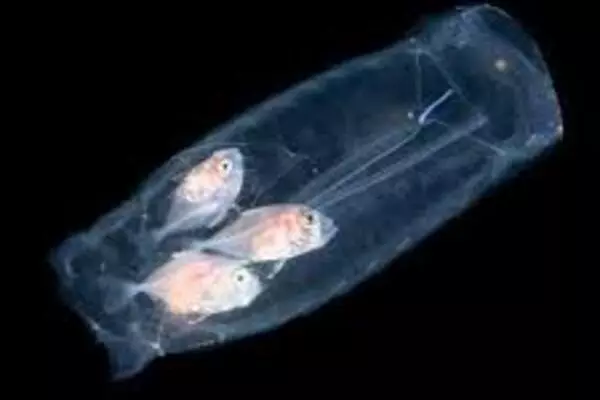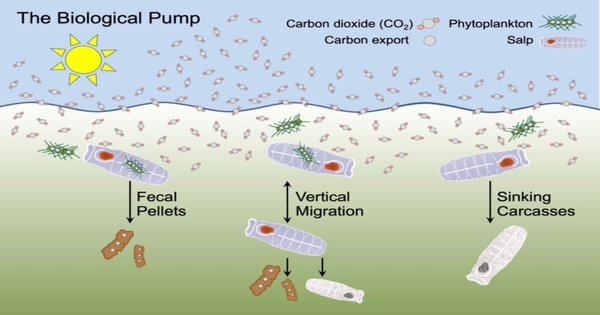Salps are a type of marine animal that look like transparent tubes and move by pumping water through their bodies. A recent study suggests that these creatures play an outsize role in damping global warming by removing large amounts of carbon from the atmosphere and transporting it to the deep sea.
Humans continue to exacerbate global warming by releasing billions of tons of CO2 into the atmosphere each year. According to a new study, a distant human relative plays an outsized role in mitigating the effects of this greenhouse gas by pumping large amounts of carbon from the ocean surface to the deep sea, where it has no effect on current warming.
Dr. Deborah Steinberg of William & Mary’s Virginia Institute of Marine Science led the study, which was published in the most recent issue of Global Biogeochemical Cycles. It reports on research conducted as part of EXPORTS, a NASA-funded four-year multi-institutional field program. Co-authors come from Maine, Bermuda, California, Newfoundland, British Columbia, and Alaska marine institutes.
EXPORTS, which stands for EXport Processes in the Ocean from RemoTe Sensing, aims to combine shipboard and satellite observations to better quantify the global impact of the “biological pump.” This is a group of biological processes that transport carbon and other organic matter from the surface ocean to the deep sea, effectively removing carbon dioxide from the atmosphere and the surface ocean. Zooplankton is tiny drifting animals that play an important role in the pump by eating phytoplankton, which incorporates carbon from carbon dioxide into their tissues during photosynthesis and then export that carbon to depth.
Our research serves as a “call to arms” to better detect and quantify these processes through the use of technology and sampling schemes that allow their inclusion in measurements and models of the biological carbon pump.
During a month-long EXPORTS expedition to the northeast Pacific Ocean in 2018, Steinberg and colleagues discovered a large bloom of a little-studied player in the biological pump: Salpa aspera, a species of gelatinous zooplankton. These “jelly barrels,” like other salps, start life with a notochord (the structure that develops into the spinal cord in humans and other vertebrates), and as adults drift through the world’s oceans like tiny transparent whales, filtering microscopic plants afloat in the water.
Three characteristics piqued the team’s interest in salps, specifically S. aspera. One feature of these organisms is their ability to reproduce asexually, rapidly cloning into massive blooms under the right conditions. Second, S. aspera is larger and filters more water than other zooplankton, resulting in larger, heavier fecal pellets. Third, it migrates up and down through the water every day, rising at night to feed on phytoplankton and scurrying to the perpetual darkness of the deep sea during the day to avoid its own predators, which include sea turtles, marine birds, and fishes.
Together, these features had led researchers to suspect that salps might play an important role in the biological pump, as large blooms of this relatively bulky zooplankton could effectively transport carbon to depth through their heavy, fast-sinking fecal pellets; vertical migrations that give those pellets a head start on their journey to depth; and the sinking of countless salp carcasses during a bloom (individual salps live only a few weeks).

However, the proof is in the pudding, and salps’ ephemeral life cycle and uneven distribution have long hampered efforts to investigate their role in carbon export and deep-sea food webs. “Salps have a ‘bloom or bust’ life cycle, with populations that are inherently patchy in space and time,” says Steinberg. As a result, it is difficult to observe or model their contribution to carbon export to the deep sea.”
Steinberg and colleagues were able to overcome these challenges during the 2018 EXPORTS expedition to the Pacific by using a variety of ocean-observation tools, ranging from traditional plankton nets and sediment traps to underwater video recorders and sonar-based computer models. Moreover, by using two research vessels – the 277-ft Roger Revelleand the 238-ft Sally Ride – the scientists were able to observe conditions not only inside the salp bloom but in surrounding waters, providing a broader geographic context for their study.
The results of the team’s unprecedented field campaign were clear. “High salp abundances, combined with unique features of their ecology and physiology, lead to an outsized role in the biological pump,” says Steinberg.
To put things in perspective, the salp bloom observed covered over 4,000 square miles (~11,000 km2), roughly the size of Connecticut. With onboard experiments demonstrating that salps can export an average of 9 milligrams of carbon per square meter at 100 meters below the bloom, the amount of carbon exported to the deep sea was approximately 100 metric tons per day. A typical passenger car emits 4.6 metric tons of CO2 per year. When these figures are compared, the carbon removed from the climate system each day of the bloom is equivalent to removing 7,500 cars from the road. When these values are adjusted using the team’s highest measured rate of salp-mediated export, the carbon offset is increased to more than 28,000 vehicles.
Moving forward, the team advocates for greater recognition of salps’ critical role in global carbon export. “Blooms like the one we observed frequently go undetected,” says Steinberg, “and their contributions to the biological pump are rarely quantified, even in some of the world’s best-studied ocean regions.” The incorporation of salp dynamics into a recently developed carbon-cycle model demonstrates the potential of salp-mediated export. Salps and other tunicates exported 700 million metric tons of carbon to the deep sea each year, equivalent to the emissions from more than 150 million cars, according to this global model.
“More use of new technologies, such as adding video imaging systems to autonomous floats, would aid in the detection of these salp blooms,” Steinberg says. “Our research serves as a “call to arms” to better detect and quantify these processes through the use of technology and sampling schemes that allow their inclusion in measurements and models of the biological carbon pump.”





